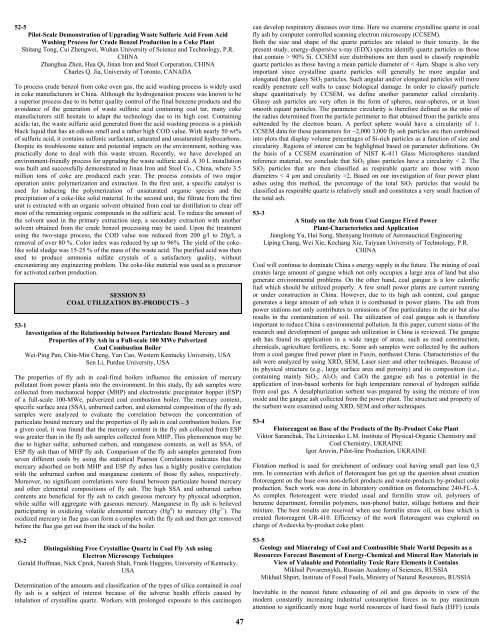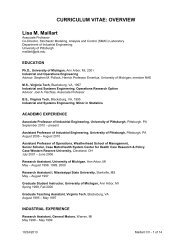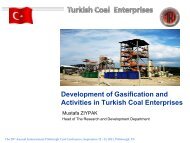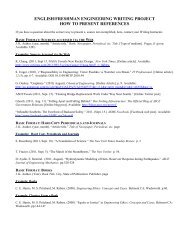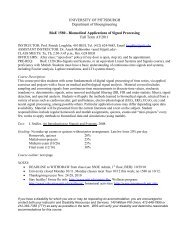Abstract Booklet 2006 - Swanson School of Engineering - University ...
Abstract Booklet 2006 - Swanson School of Engineering - University ...
Abstract Booklet 2006 - Swanson School of Engineering - University ...
Create successful ePaper yourself
Turn your PDF publications into a flip-book with our unique Google optimized e-Paper software.
52-5<br />
Pilot-Scale Demonstration <strong>of</strong> Upgrading Waste Sulfuric Acid From Acid<br />
Washing Process for Crude Benzol Production in a Coke Plant<br />
Shitang Tong, Cui Zhengwei, Wuhan <strong>University</strong> <strong>of</strong> Science and Technology, P.R.<br />
CHINA<br />
Zhanghua Zhen, Hua Qi, Jinan Iron and Steel Corperation, CHINA<br />
Charles Q. Jia, <strong>University</strong> <strong>of</strong> Toronto, CANADA<br />
To process crude benzol from coke oven gas, the acid washing process is widely used<br />
in coke manufacturers in China. Although the hydrogenation process was known to be<br />
a superior process due to its better quality control <strong>of</strong> the final benzene products and the<br />
avoidance <strong>of</strong> the generation <strong>of</strong> waste sulfuric acid containing coal tar, many coke<br />
manufacturers still hesitate to adapt the technology due to its high cost. Containing<br />
acidic tar, the waste sulfuric acid generated from the acid washing process is a pinkish<br />
black liquid that has an odious smell and a rather high COD value. With nearly 50 wt%<br />
<strong>of</strong> sulfuric acid, it contains sulfonic surfactant, saturated and unsaturated hydrocarbons.<br />
Despite its troublesome nature and potential impacts on the environment, nothing was<br />
practically done to deal with this waste stream. Recently, we have developed an<br />
environment-friendly process for upgrading the waste sulfuric acid. A 30 L installation<br />
was built and successfully demonstrated in Jinan Iron and Steel Co., China, where 3.5<br />
million tons <strong>of</strong> coke are produced each year. The process consists <strong>of</strong> two major<br />
operation units: polymerization and extraction. In the first unit, a specific catalyst is<br />
used for inducing the polymerization <strong>of</strong> unsaturated organic species and the<br />
precipitation <strong>of</strong> a coke-like solid material. In the second unit, the filtrate from the first<br />
unit is extracted with an organic solvent obtained from coal tar distillation to clear <strong>of</strong>f<br />
most <strong>of</strong> the remaining organic compounds in the sulfuric acid. To reduce the amount <strong>of</strong><br />
the solvent used in the primary extraction step, a secondary extraction with another<br />
solvent obtained from the crude benzol processing may be used. Upon the treatment<br />
using the two-stage process, the COD value was reduced from 200 g/l to 20g/l, a<br />
removal <strong>of</strong> over 80 %. Color index was reduced by up to 96%. The yield <strong>of</strong> the cokelike<br />
solid sludge was 15-25 % <strong>of</strong> the mass <strong>of</strong> the waste acid. The purified acid was then<br />
used to produce ammonia sulfate crystals <strong>of</strong> a satisfactory quality, without<br />
encountering any engineering problem. The coke-like material was used as a precursor<br />
for activated carbon production.<br />
SESSION 53<br />
COAL UTILIZATION BY-PRODUCTS – 3<br />
53-1<br />
Investigation <strong>of</strong> the Relationship between Particulate Bound Mercury and<br />
Properties <strong>of</strong> Fly Ash in a Full-scale 100 MWe Pulverized<br />
Coal Combustion Boiler<br />
Wei-Ping Pan, Chin-Min Cheng, Yan Cao, Western Kentucky <strong>University</strong>, USA<br />
Sen Li, Purdue <strong>University</strong>, USA<br />
The properties <strong>of</strong> fly ash in coal-fired boilers influence the emission <strong>of</strong> mercury<br />
pollutant from power plants into the environment. In this study, fly ash samples were<br />
collected from mechanical hopper (MHP) and electrostatic precipitator hopper (ESP)<br />
<strong>of</strong> a full-scale 100-MWe, pulverized coal combustion boiler. The mercury content,<br />
specific surface area (SSA), unburned carbon, and elemental composition <strong>of</strong> the fly ash<br />
samples were analyzed to evaluate the correlation between the concentration <strong>of</strong><br />
particulate bound mercury and the properties <strong>of</strong> fly ash in coal combustion boilers. For<br />
a given coal, it was found that the mercury content in the fly ash collected from ESP<br />
was greater than in the fly ash samples collected from MHP. This phenomenon may be<br />
due to higher sulfur, unburned carbon, and manganese contents, as well as SSA, <strong>of</strong><br />
ESP fly ash than <strong>of</strong> MHP fly ash. Comparison <strong>of</strong> the fly ash samples generated from<br />
seven different coals by using the statistical Pearson Correlations indicates that the<br />
mercury adsorbed on both MHP and ESP fly ashes has a highly positive correlation<br />
with the unburned carbon and manganese contents <strong>of</strong> those fly ashes, respectively.<br />
Moreover, no significant correlations were found between particulate bound mercury<br />
and other elemental compositions <strong>of</strong> fly ash. The high SSA and unburned carbon<br />
contents are beneficial for fly ash to catch gaseous mercury by physical adsorption,<br />
while sulfur will aggregate with gaseous mercury. Manganese in fly ash is believed<br />
participating in oxidizing volatile elemental mercury (Hg 0 ) to mercury (Hg 2+ ). The<br />
oxidized mercury in flue gas can form a complex with the fly ash and then get removed<br />
before the flue gas get out from the stack <strong>of</strong> the boiler.<br />
53-2<br />
Distinguishing Free Crystalline Quartz in Coal Fly Ash using<br />
Electron Microscopy Techniques<br />
Gerald Huffman, Nick Cprek, Naresh Shah, Frank Huggins, <strong>University</strong> <strong>of</strong> Kentucky,<br />
USA<br />
Determination <strong>of</strong> the amounts and classification <strong>of</strong> the types <strong>of</strong> silica contained in coal<br />
fly ash is a subject <strong>of</strong> interest because <strong>of</strong> the adverse health effects caused by<br />
inhalation <strong>of</strong> crystalline quartz. Workers with prolonged exposure to this carcinogen<br />
can develop respiratory diseases over time. Here we examine crystalline quartz in coal<br />
fly ash by computer controlled scanning electron microscopy (CCSEM).<br />
Both the size and shape <strong>of</strong> the quartz particles are related to their toxicity. In the<br />
present study, energy-dispersive x-ray (EDX) spectra identify quartz particles as those<br />
that contain > 90% Si. CCSEM size distributions are then used to classify respirable<br />
quartz particles as those having a mean particle diameter <strong>of</strong> < 4μm. Shape is also very<br />
important since crystalline quartz particles will generally be more angular and<br />
elongated than glassy SiO 2 particles. Such angular and/or elongated particles will more<br />
readily penetrate cell walls to cause biological damage. In order to classify particle<br />
shape quantitatively by CCSEM, we define another parameter called circularity.<br />
Glassy ash particles are very <strong>of</strong>ten in the form <strong>of</strong> spheres, near-spheres, or at least<br />
smooth equant particles. The parameter circularity is therefore defined as the ratio <strong>of</strong><br />
the radius determined from the particle perimeter to that obtained from the particle area<br />
subtended by the electron beam. A perfect sphere would have a circularity <strong>of</strong> 1.<br />
CCSEM data for these parameters for ~2,000 3,000 fly ash particles are then combined<br />
into plots that display volume percentages <strong>of</strong> Si-rich particles as a function <strong>of</strong> size and<br />
circularity. Regions <strong>of</strong> interest can be highlighted based on parameter definitions. On<br />
the basis <strong>of</strong> a CCSEM examination <strong>of</strong> NIST K-411 Glass Microspheres standard<br />
reference material, we conclude that SiO 2 glass particles have a circularity < 2. The<br />
SiO 2 particles that are then classified as respirable quartz are those with mean<br />
diameters < 4 µm and circularity >2. Based on our investigation <strong>of</strong> four power plant<br />
ashes using this method, the percentage <strong>of</strong> the total SiO 2 particles that would be<br />
classified as respirable quartz is relatively small and constitutes a very small fraction <strong>of</strong><br />
the total ash.<br />
53-3<br />
A Study on the Ash from Coal Gangue Fired Power<br />
Plant-Characteristics and Application<br />
Jianglong Yu, Hui Song, Shenyang Institute <strong>of</strong> Aeronauctical <strong>Engineering</strong><br />
Liping Chang, Wei Xie, Kechang Xie, Taiyuan <strong>University</strong> <strong>of</strong> Technology, P.R.<br />
CHINA<br />
Coal will continue to dominate China s energy supply in the future. The mining <strong>of</strong> coal<br />
creates large amount <strong>of</strong> gangue which not only occupies a large area <strong>of</strong> land but also<br />
generate environmental problems. On the other hand, coal gangue is a low calorific<br />
fuel which should be utilized properly. A few small power plants are current running<br />
or under construction in China. However, due to its high ash content, coal gangue<br />
generates a large amount <strong>of</strong> ash when it is combusted in power plants. The ash from<br />
power stations not only contributes to emissions <strong>of</strong> fine particulates in the air but also<br />
results in the contamination <strong>of</strong> soil. The utilization <strong>of</strong> coal gangue ash is therefore<br />
important to reduce China s environmental pollution. In this paper, current status <strong>of</strong> the<br />
research and development <strong>of</strong> gangue ash utilization in China is reviewed. The gangue<br />
ash has found its application in a wide range <strong>of</strong> areas, such as road construction,<br />
chemicals, agriculture fertilizers, etc. Some ash samples were collected by the authors<br />
from a coal gangue fired power plant in Fuxin, northeast China. Characteristics <strong>of</strong> the<br />
ash were analyzed by using XRD, SEM, Laser sizer and other techniques. Because <strong>of</strong><br />
its physical structure (e.g., large surface area and porosity) and its composition (i.e.,<br />
containing mainly SiO 2 , Al 2 O 3 and CaO) the gangue ash has a potential in the<br />
application <strong>of</strong> iron-based sorbents for high temperature removal <strong>of</strong> hydrogen sulfide<br />
from coal gas. A desulphurization sorbent was prepared by using the mixture <strong>of</strong> iron<br />
oxide and the gangue ash collected from the power plant. The structure and property <strong>of</strong><br />
the surbent were examined using XRD, SEM and other techniques.<br />
53-4<br />
Flotoreagent on Base <strong>of</strong> the Products <strong>of</strong> the By-Product Coke Plant<br />
Viktor Saranchuk, The Litvinenko L.M. Institute <strong>of</strong> Physical-Organic Chemistry and<br />
Coal Chemistry, UKRAINE<br />
Igor Arovin, Pilot-line Production, UKRAINE<br />
Flotation method is used for enrichment <strong>of</strong> ordinary coal having small part less 0,5<br />
mm. In connection with deficit <strong>of</strong> flotoreagent has got up the question about creation<br />
flotoreagent on the base own non-deficit products and waste-products by-product coke<br />
production. Such work was done in laboratory condition on flotomachine 240-FL-À.<br />
As complex flotoreagent were trieded usual and formilin straw oil, polymers <strong>of</strong><br />
benzene department, formilin polymers, non-phenol butter, stillage bottoms and their<br />
mixture. The best results are received when use formilin straw oil, on base which is<br />
created flotoreagent UR-410. Efficiency <strong>of</strong> the work flotoreagent was explored on<br />
charge <strong>of</strong> Avdeevka by-product coke plant.<br />
53-5<br />
Geology and Mineralogy <strong>of</strong> Coal and Combustible Shale World Deposits as a<br />
Resources Forecast Basement <strong>of</strong> Energy-Chemical and Mineral Raw Materials in<br />
View <strong>of</strong> Valuable and Potentiality Toxic Rare Elements it Contains<br />
Mikhail Povarennykh, Russian Academy <strong>of</strong> Sciences, RUSSIA<br />
Mikhail Shpirt, Institute <strong>of</strong> Fossil Fuels, Ministry <strong>of</strong> Natural Resources, RUSSIA<br />
Inevitable in the nearest future exhausting <strong>of</strong> oil and gas deposits in view <strong>of</strong> the<br />
modern constantly increasing industrial consumption forces us to pay maximum<br />
attention to significantly more huge world resources <strong>of</strong> hard fossil fuels (HFF) (coals<br />
47


